2017 MERCEDES-BENZ E43AMG Lights
[x] Cancel search: LightsPage 150 of 482
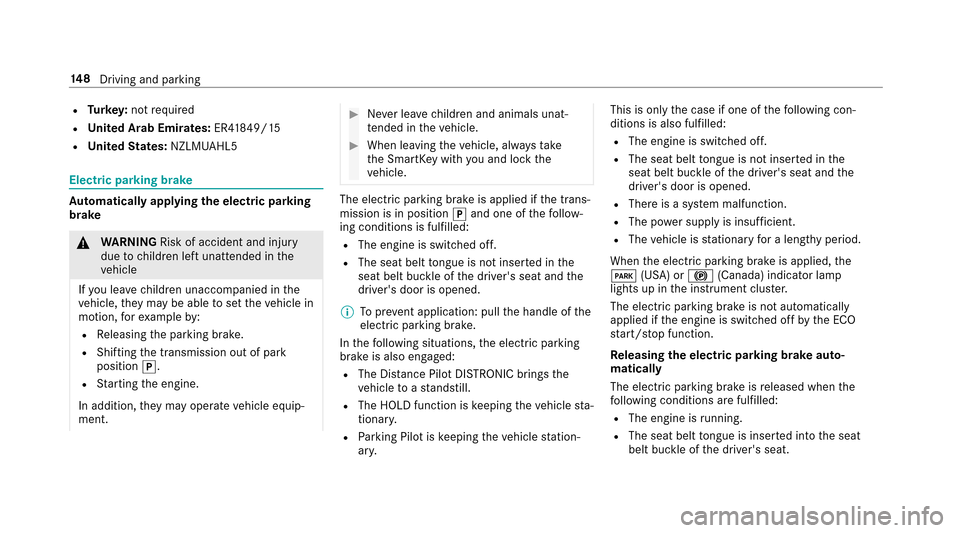
RTurkey :not requ ired
RUn ited Arab Emirates: ER41849/15
RUn ited States: NZLMUAHL5
Electric parking brake
Automatically applying the electric parking
brake
& WARNING Risk of accident and injury
due tochildren left unatte nded inthe
ve hicle
If yo u lea vechildren unaccompanied in the
ve hicle, they may be able toset theve hicle in
motion, forex ample by:
RRe leasing the parking brake.
RShifting the transmission out of park
position j.
RStarting the engine.
In addition, they may operate vehicle equip‐
ment.
#Ne ver lea vechildren and animals unat‐
te nded in theve hicle.
#When leaving theve hicle, alw aysta ke
th e SmartK eywith you and lock the
ve hicle.
The electric parking brake is applied if the trans‐
mission is in position jand one of thefo llow‐
ing conditions is fulfilled:
RThe engine is switched off.
RThe seat belt tongue is not inser ted in the
seat belt buckle of the driver's seat and the
driver's door is opened.
% Toprev ent application: pull the handle of the
electric parking brake.
In thefo llowing situations, the electric parking
brake is also engaged:
RThe Dis tance Pilot DISTRONIC brings the
ve hicle toast andstill.
RThe HOLD function is keeping theve hicle sta‐
tionar y.
RParking Pilot is keeping theve hicle station‐
ar y. This is only
the case if one of thefo llowing con‐
ditions is also fulfilled:
RThe engine is switched off.
RThe seat belt tongue is not inser ted in the
seat belt buckle of the driver's seat and the
driver's door is opened.
RThere is a sy stem malfunction.
RThe po wer supply is insuf ficient.
RThe vehicle is stationary for a lengt hyperiod.
When the electric parking brake is applied, the
F (USA) or !(Canada) indicator lamp
lights up in the instrument clus ter.
The electric parking brake is not automatically
applied if the engine is switched off bythe ECO
st art/ stop function.
Re leasing the electric pa rking brake auto‐
matically
The elect ric park ing brake is released when the
fo llo wing c
onditions are fulfilled:
RThe engine is
running.
RThe seat belt tongue is inser ted into the seat
belt buckle of the driver's seat.
14 8
Driving and pa rking
Page 153 of 482

associated damage, which may not be visible,to
th e bumpers or radiator grille, ha vethe function
of thera dar sensors checked at a qualified spe‐
cialist workshop. The driver assis tance sy stem
may no longer workproperly.
Overview of driving and driving saf ety sys‐
te ms
In this section, youwill find information about
th efo llowing driving sy stems and driving saf ety
sy stems:
R360° Camera (→page 181)
RABS ( Anti-lock Braking Sys tem) (→page 151)
RDis tance Pilot DISTRONIC (→pa ge 161)
RAIR BODY CONTROL (→page 172)
RAc tive Brake Assi st(→page 155)
RAc tive Lane Keeping Assist (→page 195)
RATTENTION ASSIST (→page 189)
RBA S (Brak eAssist System) (→page 151)
REBD ( Electronic Brakeforc eDistribution)
(→page 155)
RESP®(E lectronic Sta bility Pro gram)
(→page 152)
RDRIVE PIL OT(→page 168)
RHOLD fu nction (→page 171)
RSteering Pilot (→page 168)
RParking Pilot (→page 184)
RParking Assist PARKTRONI C (→page17 6)
RRe ar view camera (→page 179)
RCruis e control (→page 160)
RBlind Spot Assist andActive Blind Spot Assi st
(→page 193)
RTraf fic Sign Assist (→page191)
Fu nctions of ABS (anti-lock braking sy stem)
ABS regulates the brake pressure in critical driv‐
ing situations:
RDuring braking, the wheels are pr evented
from blocking, forex ample due tomaximum
full-s top braking or insuf ficient traction of the
tires.
RVe hicle steerability while braking is ensured.
RABS is active from speeds of appr ox. 5 mph
(8 km/h).
If ABS inter venes when braking, youwill feel a
pulsing in the brake pedal. The pulsating brake
pedal can be an indication of hazardous road
conditions and can ser veas a reminder totake
ex tra care while driving.
Sy stem limits
ABS may be impaired or may not function if a
malfunction has occur red and theye llow !
ABS warning lamp lights up continuously in the
instrument clus ter af terth e engine is star ted.
Fu nction of BAS (Brake Assist Sy stem)
&
WARNING Risk of an accident caused by
a malfunction in BAS (Brake Assist Sys‐
te m)
If BA S is malfunctioning, the braking dis tance
may increase in an eme rgency braking situa‐
tion.
Driving and parking 15
1
Page 154 of 482

#Depress the brake pedal with full forc e
in emer gency braking situations. ABS
pr eve nts the wheels from locking.
BA S suppo rts yo ur eme rgency braking situation
with additional brake forc e.
If yo udepr essthe brake pedal quickl y,BA S is
acti vated:
RBA S au tomatical lyboosts the brake pres‐
sure.
RBA S can short enthe braking dis tance.
RABS pr events the wheels from locking.
The brakes will function as usual once you
re lease the brake pedal. BAS is deactivated.
Functions of ESP®(Electronic Stability Pro‐
gr am)
&
WARNING Risk of skidding if ESP®is
malfunctioning
If ESP
®is malfunctioning, ESP®cannot car ry
out vehicle stabilization. In addition, other
driving saf etysy stems are switched off.
#Drive on carefull y.
#Have ESP®checked at a qualified spe‐
cialist workshop.
&
WARNING Risk of skidding if ESP®is
deactivated
If yo u deactivate ESP
®, ESP®cannot car ry
out vehicle stabilization.
#ESP®should only be deactivated in the
fo llowing situations.
ESP®monitors and impr oves driving stability and
traction, particular ly inthefo llowing situations:
RWhen pulling away on wet or slippe ryroads.
RWhen braking.
RIn stro ng sidewinds when you are driving
fast erthan 50 mph (80 km/h).
ESP
®can stabilize theve hicle byinter vening in
th efo llowing ways:
ROne or more wheels are braked.
RThe engine output is adap ted according to
th e situation.
ESP
®is deactivated if the ESP®OFF å warn‐
ing lamp lights up continuously in the instrument
clus ter:
RDriving stability will no longe r be improved.
RCrosswind Assist is no longer active.
RThe drive wheels could spin.
RETS/4ETS traction control is still active.
% Even when ESP
®is deactivated, you are still
assis tedby ESP®when braking.
ESP
®is inter vening if the ESP®÷ warning
lamp flashes in the instrument clus ter:
RDo not deacti vate ESP®.
15 2
Driving and pa rking
Page 155 of 482
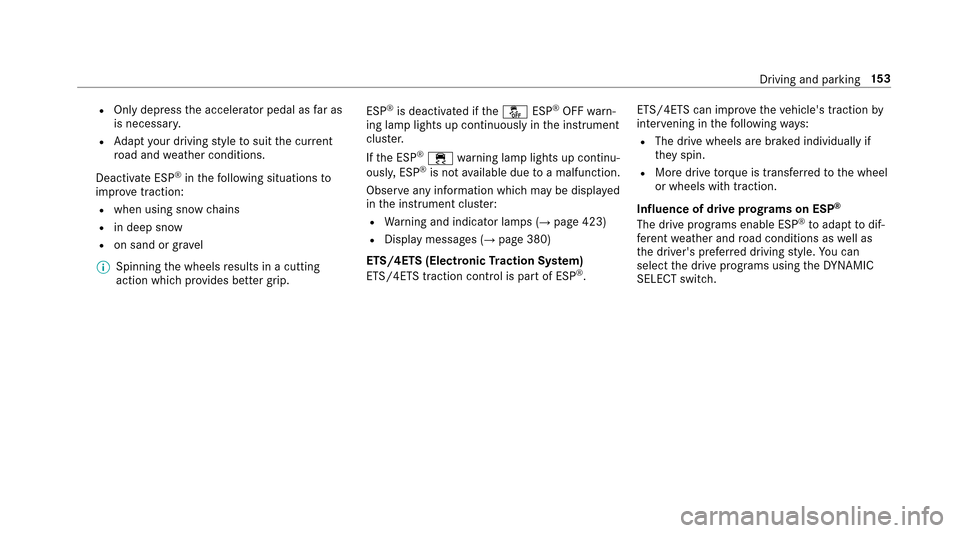
ROnly depressthe accelera tor pedal as far as
is necessar y.
RAdapt your drivin gst yle to suit the cur rent
ro ad and weather conditions.
Deactivate ESP
®in thefo llowing situations to
impr ove traction:
Rwhen using snow chains
Rin deep snow
Ron sand or gr avel
% Spinning the wheels results in a cutting
action which pr ovides better grip. ESP
®is deactivated if
theå ESP®OFFwarn‐
ing lamp lights up continuously in the instrument
clus ter.
If th e ESP
®÷ warning lamp lights up continu‐
ousl y,ESP®is not available due toa malfunction.
Observ e any information which may be displa yed
in the instrument clus ter:
RWa rning and indicator lamps (→page 423)
RDisplay messages (→page 380)
ETS/4ETS (Electronic Traction Sy stem)
ETS/4E TStraction control is pa rtof ESP
®. ETS/4ETS can impr
ovetheve hicle's traction by
inter vening in thefo llowing ways:
RThe drive wheels are braked individually if
they spin.
RMore drive torque is transferred tothe wheel
or wheels with traction.
Influence of drive prog rams on ESP
®
The drive prog rams enable ESP®to adapt todif‐
fe re nt we ather and road conditions as well as
th e driver's prefer red driving style. You can
selec
t the drive prog rams using theDY NA MIC
SELECT switch.
Driving and parking 15
3
Page 157 of 482
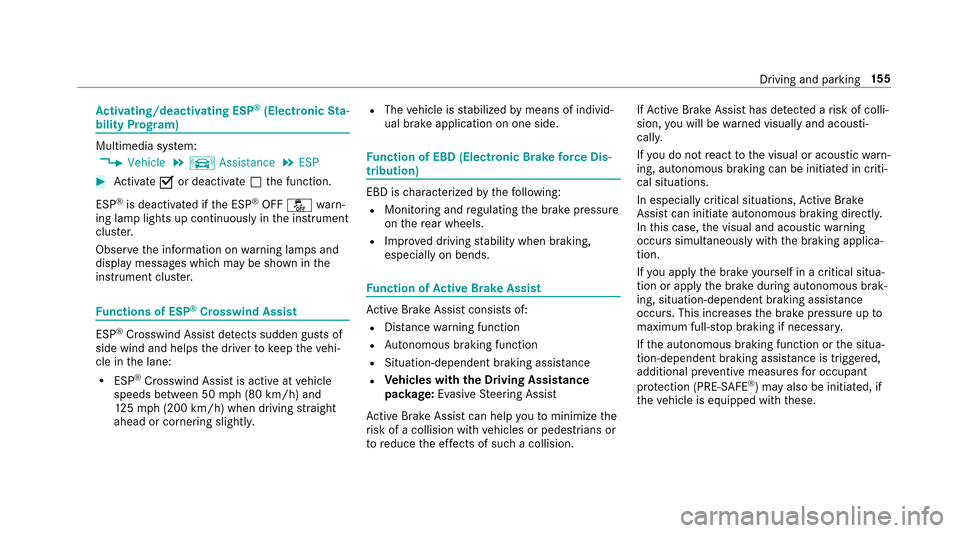
Activating/deactivating ESP®(Electronic Sta‐
bility Prog ram)
Multimedia sy stem:
,�9�H�K�L�F�O�H.k �$�V�V�L�V�W�D�Q�F�H.�(�6�3
#Activate Oor deacti vate ª the function.
ESP
®is deactivated if the ESP®OFF å warn‐
ing lamp lights up continuously in the instrument
clus ter.
Obser vethe information on warning lamps and
display messages which may be shown in the
instrument clus ter.
Fu nctions of ESP®Crosswind Assist
ESP®Crosswind Assist de tects sudden gust s of
side wind and helps the driver tokeep theve hi‐
cle in the lane:
RESP®Crosswind Assist is active at vehicle
speeds between 50 mph (80 km/h) and
12 5mp h (200 km/h) when driving stra ight
ahead or cornering slightly.
RThe vehicle is stabilized bymeans of individ‐
ual brake application on one side.
Fu nction of EBD (Electronic Brake forc e Dis‐
tribution)
EBD is characterized bythefo llowing:
RMonitoring and regulating the brake pressure
on there ar wheels.
RImpr oved driving stability when braking,
especially on bends.
Fu nction of Active Brake Assi st
Active Brake Assi stconsist s of:
RDistance warning function
RAu tonomous braking function
RSituation-dependent braking assist ance
RVehicles with the Driving Assistance
pa ckage: Evasi veSteering Assist
Ac tive Brake Assi stcan help youto minimize the
ri sk of a collision with vehicles or pedestrians or
to reduce the ef fects of such a collision. If
Ac tive Brake Assi sthas de tected a risk of colli‐
sion, you will be warned visually and acousti‐
call y.
If yo udo not react tothe visual or acoustic warn‐
ing, autonomous braking can be initiated in criti‐
cal situations.
In especially critical situations, Active Brake
Assi stcan initiate autonomous braking direct ly.
In this case, the visual and acoustic warning
occurs simultaneously with the braking applica‐
tion.
If yo uappl yth e brake yourself in a critical situa‐
tion or apply the brake during autonomous brak‐
ing, situation-dependent braking assis tance
occurs . This increases the brake pressure up to
maximum full-s top braking if necessar y.
If th e autonomous braking function or the situa‐
tion-dependent braking assis tance is trig gered,
additional pr eventive measure sfo r occupant
pr otection (PRE-SAFE®) may also be initiated, if
th eve hicle is equipped with these.
Driving and parking 15
5
Page 158 of 482
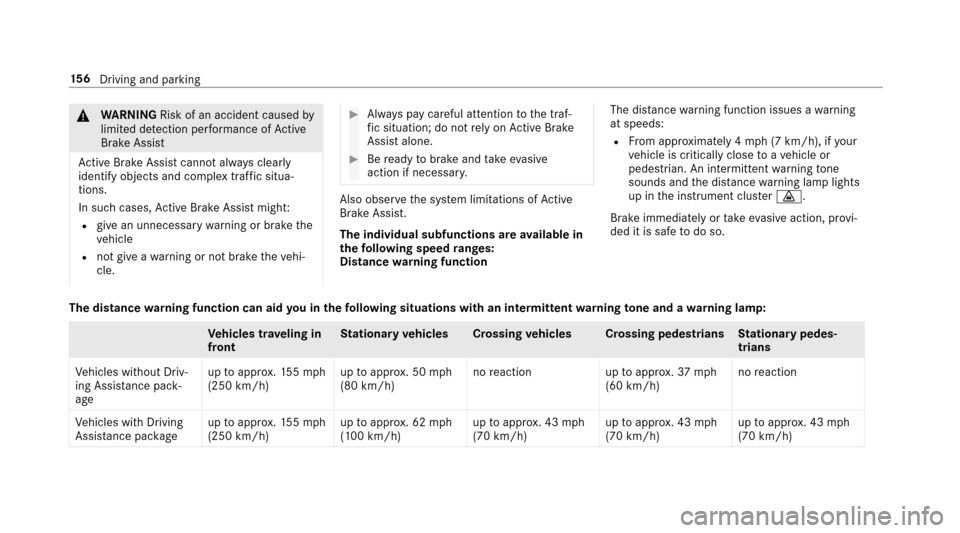
&WARNING Risk of an accident caused by
limited de tection per form ance of Active
Brake Assi st
Ac tive Brake Assi stcannot al ways clear ly
identify objects and complex traf fic situa‐
tions.
In such cases,Active Brake Assi stmight:
Rgive an unnecessa rywa rning or brake the
ve hicle
Rnot give a warning or not brake theve hi‐
cle.
#Alw ays pay careful attention tothe traf‐
fi c situation; do not rely on Active Brake
Assi stalone.
#Be ready tobrake and take evasive
action if necessar y.
Also observethe sy stem limitations of Active
Brake Assi st.
The individual subfunctions are available in
th efo llowing speed ranges:
Distance warning function The dis
tance warning function issues a warning
at speeds:
RFr om appr oximately 4 mph (7 km/h), if your
ve hicle is critically close toave hicle or
pedestrian. An intermittent warning tone
sounds and the dis tance warning lamp lights
up in the instrument clus ter·.
Brake immediately or take evasive action, pr ovi‐
ded it is safe todo so.
The distance warning function can aid you in thefo llowing situations with an intermit tent wa rning tone and a warning lamp:
Ve hicles tr aveling in
front St
ationary vehicles Crossing vehicles Crossing pedestrians Stationary pedes‐
trians
Ve hicles without Driv‐
ing Assis tance pa ck‐
age up
toappr ox.15 5mp h
(250 km/h) up
toappr ox. 50 mph
(80 km/h) no
reaction uptoappr ox.37 mph
(60 km/h) no
reaction
Ve hicles with Driving
Assis tance pa ckage up
toappr ox.15 5mp h
(250 km/h) up
toappr ox. 62 mph
(100 km/h) up
toappr ox. 43 mph
(70 km/h) up
toappr ox. 43 mph
(70 km/h) up
toappr ox. 43 mph
(70 km/h)
15 6
Driving and pa rking
Page 177 of 482
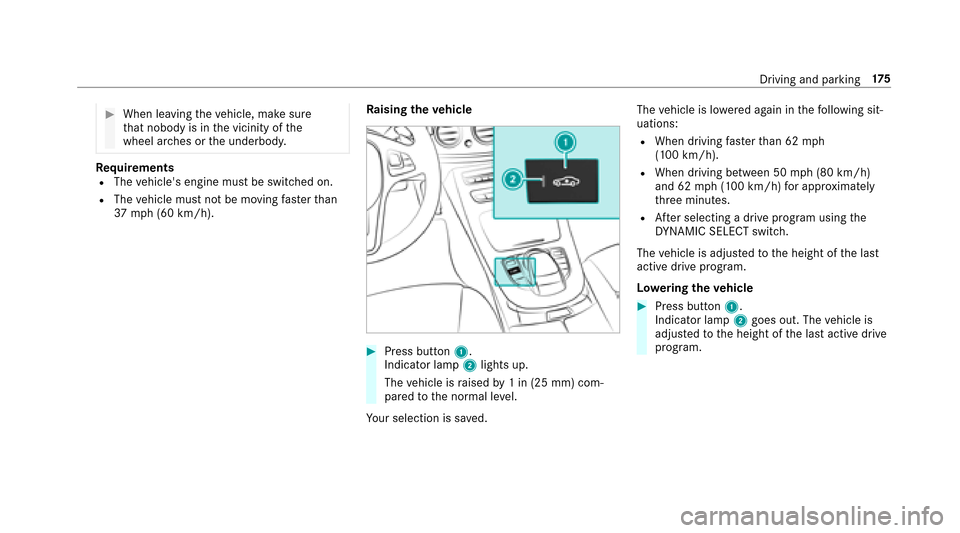
#When leavingtheve hicle, make sure
th at nobody is in the vicinity of the
wheel ar ches or the underbody.
Re quirementsRThe vehicle's engine must be switched on.
RThe vehicle must not be moving fasterthan
37 mph (60 km/h). Ra
ising theve hicle
#Press button 1.
Indicato r lamp2lights up.
The vehicle is raised by1 in (25 mm) com‐
pared tothe normal le vel.
Yo ur selection issave d. The
vehicle is lo wered again in thefo llowing sit‐
uations:
RWhen driving fasterthan 62 mph
(100 km/h).
RWhen driving between 50 mph(8 0 km/h)
and 62 mph (100 km/h) for app roxima tely
th re e minutes.
RAf ter selecting a drive program using the
DY NA MIC SELECT switch.
The vehicle is adjus tedto the height of the last
active drive program.
Lo weri ngtheve hicle
#Press button 1.
Indicato r lamp2goes out. The vehicle is
adjus tedto the height of the last active drive
program.
Driving and parking 17
5
Page 183 of 482
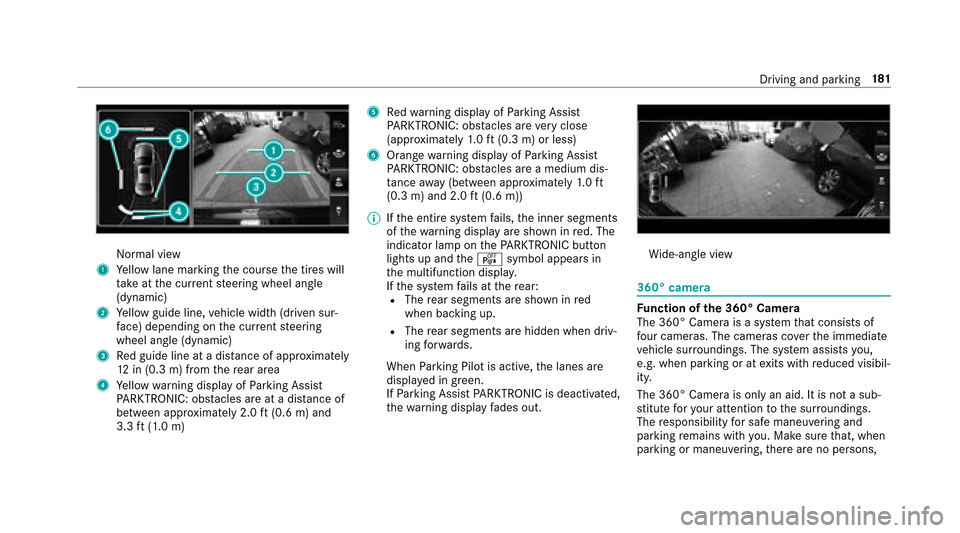
Normal view
1Yellow lane marking the course the tires will
ta ke atthe cur rent steering wheel angle
(dynamic)
2Ye llow guide line, vehicle width (driven sur‐
fa ce) depending on the cur rent steering
wheel angle (dynamic)
3Re d guide line at a dis tance of appr oximately
12 in (0.3 m) from there ar area
4Ye llow warning display of Parking Assist
PA RKTRONIC: obstacles ar eat adis tance of
between appr oximately 2.0 ft(0.6 m) and
3.3 ft(1.0 m)
5Re dwa rning display of Parking Assist
PA RKTRONIC: obstacles ar eve ry close
(appr oximately 1.0 ft (0.3 m) or less)
6Orange warning display of Parking Assist
PA RKTRONIC: obstacles ar e amedium dis‐
ta nce away (between appr oximately 1.0 ft
(0.3 m) and 2.0 ft(0.6 m))
% Ifth e entire sy stem fails, the inner segments
of thewa rning display are shown in red. The
indicator lamp on thePA RKTRONI Cbut ton
lights up and theé symbol appears in
th e multifunction displa y.
If th e sy stem fails at there ar:
RThe rear segments are shown in red
when backing up.
RThe rear segments are hidden when driv‐
ing forw ards.
When Parking Pilot is active, the lanes are
displa yed in green.
If Pa rking Assist PARKTRONI Cis deacti vated,
th ewa
rnin
g display fades out.
Wi de-angle view
360° camera
Fu nction of the 360° Camera
The 360° Camera is a sy stem that consists of
fo ur cameras. The cameras co verth e immediate
ve hicle sur roundings. The sy stem assists you,
e.g. when parking or at exits with reduced visibil‐
ity.
The 360° Camera is only an aid. It is not a sub‐
st itute foryo ur attention tothe sur roundings.
The responsibility for safe maneu vering and
pa rking remains with you. Make sure that, when
parking or maneuvering, there are no persons,
Driving and parking 18
1